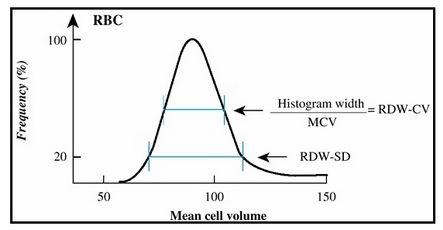Red Cell Distribution Width is a measure of the range of sizes of red blood cells which is usually included in a modern, automated blood testing machine. We should have our red blood cells in a tight band of sizes with few small or large cells. If we are suffering from two issues - one that makes cells smaller (e.g. iron deficiency anaemia) and one that makes them larger (e.g. pernicious anaemia) we often see an increase in the range of sizes - which is shown as a higher RDW number.
This paper suggests that in people with no other known reason for having a high RDW, seeing an elevated RDW could indicate Hashimoto's.
The second paper says similar but is a few years old.
Exp Clin Endocrinol Diabetes. 2014 Nov;122(10):572-4. doi: 10.1055/s-0034-1383564. Epub 2014 Nov 7.
Could Red Cell Distribution Width be a Marker in Hashimoto's Thyroiditis?
Aktas G1, Sit M2, Dikbas O3, Tekce BK4, Savli H1, Tekce H1, Alcelik A1.
Abstract
AIMS:
Hashimoto's Thyroiditis (HT) is the most common autoimmune thyroiditis worldwide and characterized with lymphomonocytic inflammation of the thyroid gland. Red cell distribution width (RDW) reflects erythrocyte anisocytosis and besides it increases in iron deficiency anemia, recent studies reported that RDW was also associated with conditions characterized with overt or subclinical inflammation. We aimed to answer whether RDW increased in Hashimoto's thyroiditis.
METHODS:
Patients with HT admitted to outpatient clinic of our hospital were included to the study. Patients with anemia (especially iron deficiency), diabetes mellitus, chronic inflammatory disease and on medication that may affect hemogram results (e. g., aspirin) excluded from the study. Patient characteristics, thyroid stimulating hormone (TSH), Free T3 (FT3), Free T4 (FT4), Anti-thyroid peroxidase (Anti-TPO), Anti-Thyroglobulin (Anti-TG), leukocyte count (WBC), Hemoglobin (Hb), Hematocrit (Htc), mean corpuscular volume (MCV), RDW and platelet count (PLT) values of the study cohort were obtained from computerized database of our institution.
RESULTS:
There was no significant difference between study and control groups in terms of WBC, Hb, Htc, MCV, PLT, PDW and FT3 levels. However, FT4 level was significantly lower and TSH was significantly higher in study group compared to controls. RDW was significantly increased in study group compared to control group.
CONCLUSION:
We suggest that elevated RDW values in patients without iron deficiency anemia may require further evaluation for HT, especially in female population.
© Georg Thieme Verlag KG Stuttgart · New York.
PMID:
25380549
[PubMed - in process]
ncbi.nlm.nih.gov/pubmed/253...
biomedscidirect.com/486/rol...
This is a heavyweight article on the meaning of RDW:
emedicine.medscape.com/arti...
This link includes a short section on RDW - which seems to say that it should be left to haematology to interpret. Which would be fine if results with elevated RDW were actually sent to haematology for interpretation!
patient.co.uk/doctor/full-b...
Rod
